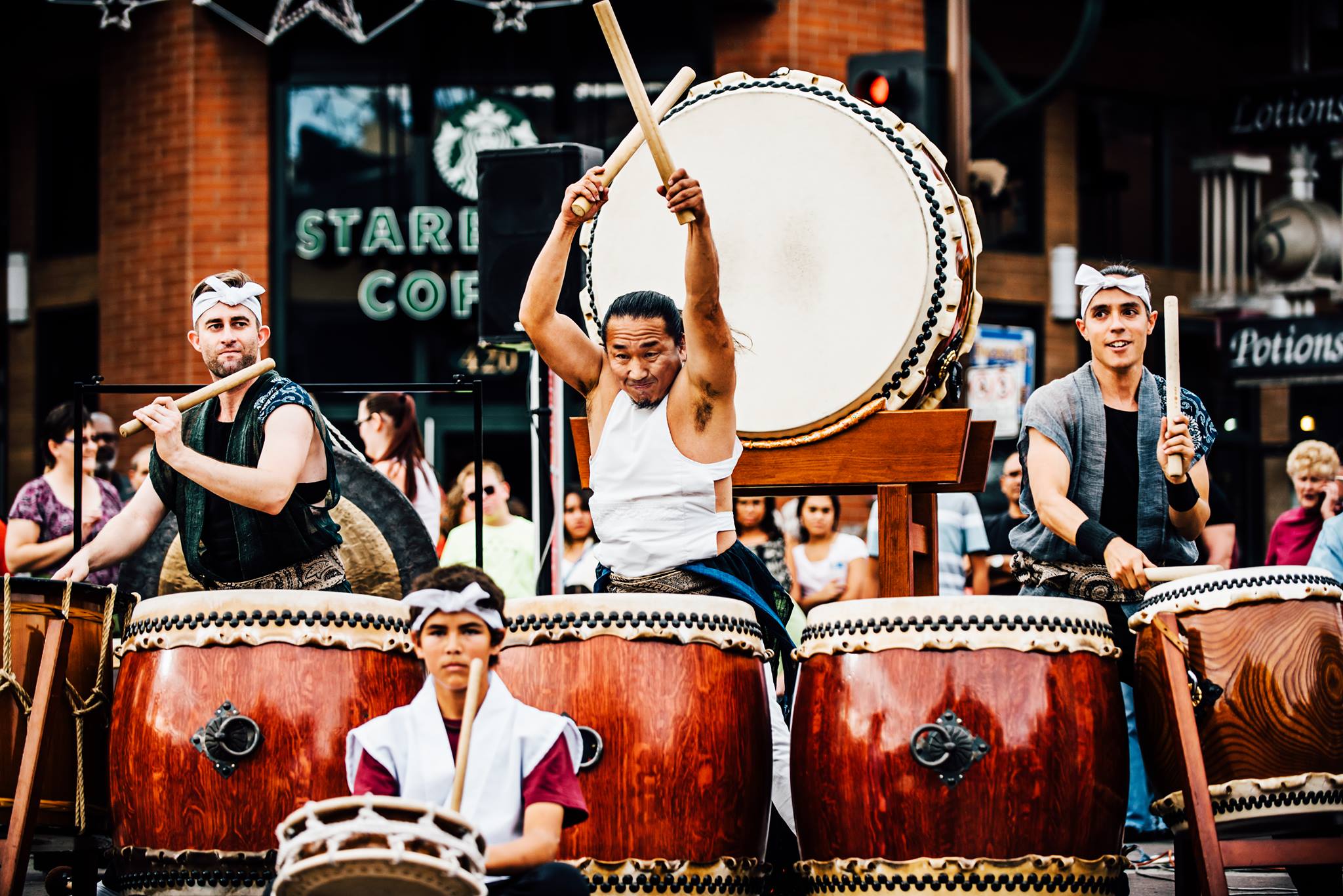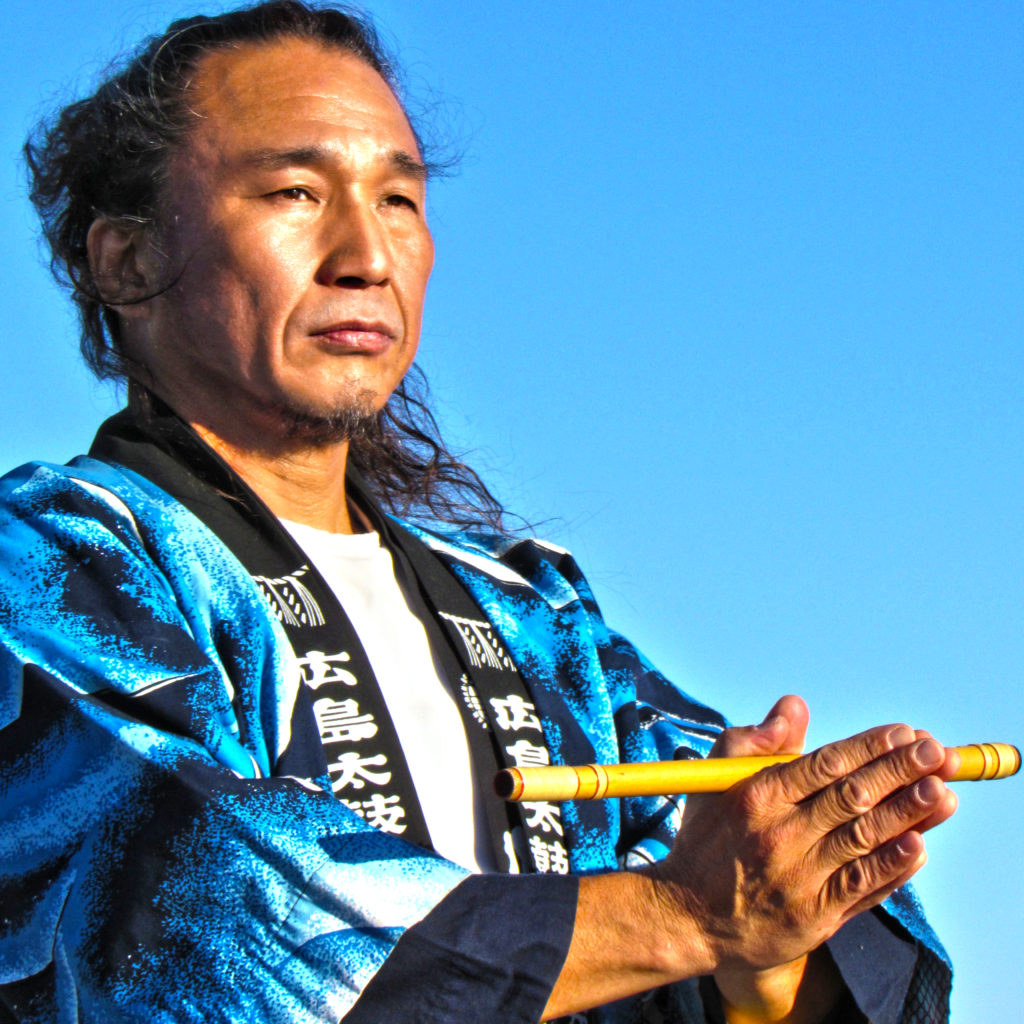Writer Amanda Christmann
Photography Courtesy of Eriko Saxon
[dropcap]N[/dropcap]o matter our origins, our ancestral lines began with rhythms and beats that remain part of us today. If we allow them, those timeless percussive booms can transcend time, space, race, religion and our personal identities, returning us to the most basic elements of our humanity.
For Ken Koshio, returning to his rhythmic roots has been an exercise in personal growth and a mission in uniting an international community hungry for common threads.
Though music has always been his passion, it took coming to the United States from his native Japan to realize his inherent connection to taiko, which translates roughly into “drumming beats” and “ancient times.”
Koshio grew up in Nagoya, Japan, a generation after the war that caused a deep rift between Japan and the United States. He hadn’t heard about internment camps where Japanese Americans were held prisoner, and though there was anti-American sentiment, especially among older generations, he only thought fondly of the United States for its vibrant culture and opportunities.
In 1998, Koshio moved to the United States as a musician. He’d grown up on everything from American rock and roll to reggae, and loved Simon and Garfunkel, The Beatles and other Euro-American bands. He emulated his favorites as a street singer in Los Angeles, playing on corners and in coffeehouses throughout the city. People also began asking him to make origami, one of his favorite childhood art forms.
Then came 9/11.
“People said 9/11 was like a second Pearl Harbor,” he said. “When we were fighting, a lot of Japanese hated Americans. We were controlled by a lot of images in Japan from Japanese media. It was the same thing here.”
Koshio saw that the messages Americans were hearing were aimed toward encouraging war against Iraq.
“I wanted to reach to people in my way,” he says. “Fifty to 60 years ago, we were enemies. Now we are friends, but how much can I understand if don’t see those people?
“In big cities, people have more opportunities to meet people from different types of cultures. I wanted to see those places.”
True to his rock and roll roots, Koshio headed east on Route 66. His mission was much bigger than simply meeting people; he wanted to create dialogue and encourage people to unite. He used what he knew: origami.
The crane is the Japanese symbol for peace. Simple to create and easy to carry, he decided to ask people to create origami cranes so he could release them at Ground Zero in New York. He called it his Thousand Cranes Tour.
By the time he reached the site where the World Trade Center towers had fallen, he’d collected 3,000 cranes from across the country. Japanese supporters, many of them strangers, also heard about what Koshio was doing and sent 7,000 more. He brought them all to the site and put on a peace concert that was heartfelt and that carried a message of peace that many people were longing to hear.
“In our culture, we make 1000 cranes which is our standard number and 10,000 is exactly 10 times—10 times of energy I felt,” he said.
The project unlocked something in Koshio’s soul that he didn’t know existed.
On his way back to Los Angeles, he made stops along the way. One was in Sedona, where he performed at Oak Creek Brewery. When his son was born in Sedona in July 2003, he decided to make Arizona a more permanent home.
“One day, I was banging a drum by myself early in the morning, and the feeling I got made me really cry. I realized that the rock and roll, blues and reggae—any type of favorite music I had been playing—was not in my blood since it was not Japanese music.
“When I banged the drum, I felt that the music I needed to learn was the vibe and beat of the drum already in me, even at a DNA level. I began looking at how can I express my feeling with the music. Then I started to practice taiko seriously.”
Ironically, it was an American woman who expanded Koshio’s knowledge of taiko. Esther Vandecar, who had taught English in Hiroshima, was passionate about taiko. She was playing in Phoenix and invited Koshio to join her. She introduced Koshio to the art behind taiko, and they began to play together.
Vandecar taught Koshio the history of taiko, but in the process, he connected with part of himself he hadn’t known.
“We started to do basic things here. I realized that it was already in me. She was passing songs along to me, but at the same time she didn’t realize the importance,” Koshio says. “Many of these tunes have been passed along for thousands of years. Somehow this American lady brought them back to Phoenix, Arizona.”
Since then, Koshio has dedicated his time to learning and sharing his message through taiko.
“Taiko creates something to remind today’s world how can we make something to be today’s way instead of fighting each other. It’s a fusion, and a means toward a peaceful world.”
In recent years, he has joined indigenous drummers and other musicians from all over the world, including Native Americans and Africans, to use ancient rhythms to return to the basics of human connection.
“Drumming is our heartbeat,” he says. “Every single indigenous people have some type of drumming. Drumming is our first language to communicate. Native Americans and Africans from all over Africa are playing similar types of drums.
“We’re coming from different places, but the meanings and the root of the beat is coming from our ancestors.”
That universal language surpasses cultural and linguistic boundaries, even among the musicians.
“If we can communicate well as musicians, it’s not just how many bars or how many beats or patterns we can play together. Drumming is the most basic communication style. Even though we have different indigenous languages, drumming belongs to Mother Earth. Its frequency gives us a lot of great vibrations to heal.”
Today, Koshio is an award-winning drummer and activist who holds a certified teaching license of Hiroshima Jidaiko indigenous taiko drumming under his master, Mr. Munakata. He shares his beliefs, knowledge and experience in his dojo and shares Japanese culture to school children through origami, calligraphy, folk tales, folk music, taiko, and other Japanese instruments.
He tours both the United States and Japan, often collaborating with Native musicians and hoop dancers, including six-time world champion Derrick Suwaima Davis, and collaborates with artists and musicians to create stage shows that share music and art with multicultural audiences. In 2013, he went to India as a special guest to participate in a world music orchestra, which set a Guinness World Record.
June 1, Koshio will be part of his latest collaboration, Migrations, at Scottsdale Center for the Performing Arts. Joined by Suwaima Davis and a host of other artists and musicians, this not-to-be-missed concert is intended to celebrate the colorful diversity of cultures and generations.
“As I continue to learn from new experiences, I am humbled as more and more,” he says. “I realize just how small I am in this world. I realize we need to connect with one another to be able to build something strong and solid. Through trust and standing together, and walking toward the future to save this Mother Earth we love for future generations.
“My goal is to teach people that we are one. One love. We can connect our heritage, ancestries and roots to allow us all to become one on this planet.”
Migrations Taiko Extravaganza 2019
June 1 | Scottsdale Center for the Performing Arts | 7380 E. 2nd St., Scottsdale | $25–$55 | scottsdaleperformingarts.org








Comments by Admin